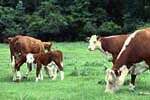|
TV pictures of cattle staggering and collapsing spread public horror for this appalling condition in the UK national herd. The epidemic lasted six years with over 180,000 cases confirmed in the UK between November 1986 and November 2002. Most of the herds (63%) affected are dairy herds, 27% are beef suckler herds. This reflects the fact that dairy cattle receive more supplementary feed, which used to contain meat and bone meal, than do beef suckler cattle. Since 1989, BSE has been confirmed in much of western and eastern Europe, and in Canada, Israel, Japan and Oman. The greatest concentration, outside of UK, is in France, Germany, Ireland, Spain and Switzerland. Some of these contaminations are due to same habit of feeding MBM, others have imported the disorder. For distribution of BSE by countries. BSE was found for the first time in Canada and USA in 2003. Many countries are boycotting their beef.
In 2001, the EU passed the TSE (Transmissible Spongiform Encephalopathies) Regulation to target animal and public health risks resulting from all animal TSE. It governs the entire chain of production regarding the market of live animals and products of animal origin. There are rules for the monitoring of TSE, and the removal of specified risk material and the prohibition of certain animal feeding. It also introduces trade rules covering import and export. There is a current debate whether the Food Standards Agency should lift the ban on human consumption of older cattle (known as the Over Thirty Month or OTM rule). Older cattle are thought to be more likely to carry BSE prions. This cull accounts for the destruction of 20% of all cattle each year. DEFRA considered whether MBM from these cattle could be spread on the ground as fertilser. However Spongiform Encephalopathy Advisory Committee (SEAC) is not on favour. For more Food Commission on OTM rule (pdf). |
© 2003 EP@W Publishing Co Ltd
Photos courtesy of http://www.usda.gov


